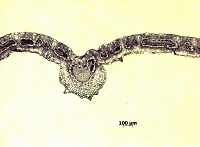Standardization of Euphorbia hirta with Chemical Compounds Identification (GC-MS)
Keywords:
E. hirta, FTIR fingerprints, heavy metals, microscopical, macroscopical standardizationAbstract
The present study was intended to evaluate the various pharmacognostical procedures in the leaves of E. hirta, (Euphorbiaceae). The various pharmacognostical parameters were carried out as per WHO guidelines procedure i.e., macroscopic and microscopic evaluation, heavy metal analysis, functional group analysis by Fourier Transform Infrared (FTIR) spectroscopy and assay. The study was extended with analyzing the chemical compounds identification in the extract of E. hirta by using GC-MS. The assay part of standardization involved determination of the antioxidant activity (DPPH assay) which could help assesses the chemical effects and establishes curative values. The extracts showed an antioxidant activity above 50%, independent of the extraction time. Six major peaks in the range of 600 - 1500 and 2800 - 3400 cm-1 were observed in the FTIR spectra. The chemical constituent aspect of standardization involves quantification of the main chemical components in E. hirta. The GC-MS method used for quantification of 1,3,4,5-tetrahydroxycyclohexanecarboxylic acid in the extract was rapid, accurate, precise, linear (R2 = 0.9981), rugged and robust. The concentrations of heavy metals determined in E. hirta extract are well below the permissible limit. The result of the pharmacognostical standardization of this plant serves as a reference piece and helps in future identification and authentication of this plant specimen.
References
. Gaedcke F, Steinhoff B and Blasius
H. (2003) Herbal Medicinal Products:
Scientific and Regulatory Basis for
Development, Quality Assurance and
Marketing Authorisation.
Wissenschaftfliche, Stuttgart, CRC
Press, Boca Raton, USA. pp. 37–52.
. Razmovski-Naumovski V, Tongkaoon W, Kimble B, Qiao V.L, Beilun L,
Li K.M, Roufogalis B, Depo Y, Meicun
Y and Li QG.. Multiple
Chromatographic and Chemometric
Methods for Quality Standardisation
of Chinese Herbal Medicines. World
Sci. Technol. 2010; 12: 99-106.
. de Padua LS, Bunyapraphatsara N
and Lemmens RHMJ. (1999) Plant
Resources of South-East Asia
No.12(1), Medicinal and poisonous
plants 1, Prosea Foundation, Bogor,
Indonesia. 268- 326.
. Lanhers MC, Fleurentin J, Dorfman
P, Mortier F and Pelt JM. Analgesic,
antipyretic and anti-inflammatory
properties of Euphorbia hirta. Planta
Med.1991; 571: 225-231.
. Anonymous. (2008) Euphorbiahirta
L, Available at:
http://florabase.calm.wa.gov.au/brow
se/profile/4629. Access on 31 May
. Evans WC. (1996) Trease and
Evans’ Pharmacognosy. 14th ed.,
W.B. Saunders Company Limited,
London, UK. 545–546.
. Brain KR and Turner TD. (1975) The
practical evaluation of
phytopharmaceuticals. Wright
Sciencetechnica, Bristol, UK. 81–82.
. Torey A, Sasidharan S, Latha LY,
Sudhakaran S and Ramanathan S.
Antioxidant activity and total phenolic
content of methanol extracts of Ixora
coccinea. Pharma. Biol. 2010; 48:
-1123.
. Torey A, Sasidharan S, Yeng C and
Yoga Latha L. Standardization of
Cassia spectabilis with respect to
authenticity, assay and chemical
constituent analysis. Molecules.
; 15: 3411-3420.
. Ghaedi M, Niknam K, Shokrollahi A,
Niknam E, Rajabi HR and Soylak M.
Flame atomic absorption
spectrometric determination of trace
amounts of heavy metal ions after
solid phase extraction using modified
sodium dodecyl sulfate coated on
alumina. J. Hazard. Mater. 2008; 155:
-127.
. WHO. (1998) Quality Control
Methods for Medicinal Plants
Materials, Document No.
WHO/PHARMA/92.559/rev.1, World
Health Organization, Geneva,
Switzerland.
. Yadav NP, Thakur M and Dixit VK.
(2009) Standardization of
herbal/Ayurvedic formulations. In
Recent Progress in Medicinal Plants.
Vol. 24, Govil, J.N. Singh V.K. (Eds.).
Studium Press LLC, Houston, Texas,
USA. 25–26.
. Lazarowych NJ and Pekos P. Use of
fingerprinting and marker
compounds for identification and
standardization of botanical drugs:
Strategies for applying
pharmaceutical HPLC analysis to
herbal products. Drug Info. J. 1998;
: 497–512.
. Chin BH, Tallant MJ, Duane WC and
Sullivan LJ. Metabolism of
carbamate insecticide thiofanox in
rats. J. Agric. Food Chem. 1980; 28:
-1090.
. Pero RW, Lund H and Leanderson T.
Antioxidant Metabolism Induced by
Quinic Acid. Increased Urinary
Excretion of Tryptophan and
Nicotinamide. Phytother. Res. 2009;
: 335–346.
. Praveen Kumar P, Kumaravel S and
Lalitha C. Screening of antioxidant
activity, total phenolics and GC-MS
study of Vitex negundo. Afr. J.
Biochem. Res. 2010; 4: 191-195.
. Liang YZ, Xieb P and Chan K.
Quality control of herbal medicines.
J. Chromatogr. B. 2004; 812: 53–70.
. WHO. (1997) WHO guidelines for
assessing quality of herbal
medicines with reference to
contaminants and residues, World
Health Organization, Geneva,
Switzerland.
. Jones JW. (1998) In Quantitative
Trace Analysis of Biological
Materials. Chapter 20, McKenzie,
Η.Α., Smythe, L.E. (Eds.). Elsevier
Science, New York City, NY, USA.
. McGrath SP and Smith S. (1990)
Chromium and Nickel in heavy
metals in soils. In Alloway B.J. (ed.).
Blackie, Glasgow, UK. 125.
. Koleva II, van Beek TA, Linssen
JPH, de Groot A and Evstatieva LN.
Screening of plant extracts for
antioxidant activity: a comparative
study on three testing methods.
Phytochem. Analysis. 2001; 13: 8-



